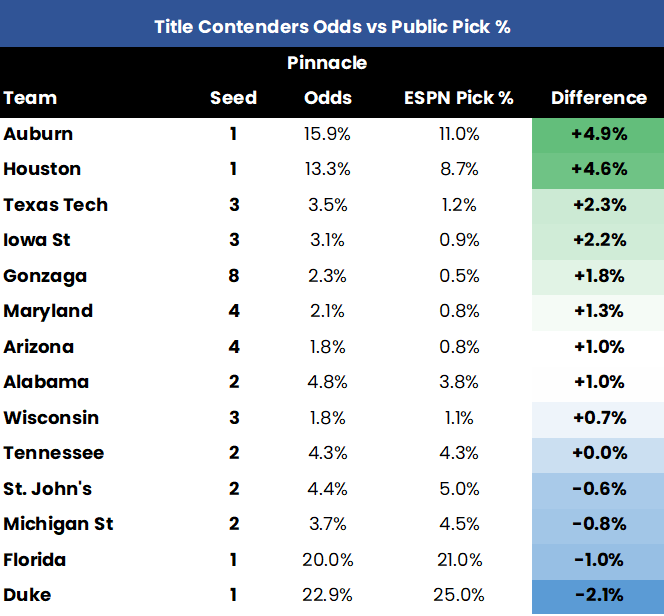
March Madness is upon us once again and for many this is the best sporting event of the year. Even for those who don’t care much about college basketball or even have not paid any attention during the season, there is a likelihood that you will be filling out a bracket. First and foremost, this is freaking hard and I hate to break it to everyone out there but there is a very high likelihood that you won’t win your pool. Even the people who have watched and studied the game all season, they struggle as much or even more to get things right. Personally, I love college basketball, but I have paid less attention to the sport this year than any other in my lifetime. Priorities get in the way and so I am less in tune with these team than ever before. Honestly outside of Cooper Flagg I would be hard pressed to name many other players. If you are looking for a deep dive into these teams, players, etc there are so many good resources out there who do a good job of that and will tweet a few this week.
With that being said, I have been filling out brackets since I was probably in 5th grade. And I love it. I do believe that are some basic tenants to follow if you want to give yourself a decent chance at winning or placing in your pool (notice I said give yourself a chance, there are no guarantees with any of this). For maybe the 20-25% of the people out there these are things you already know and understand so it’s likely not going to be anything new or additive. But for the vast majority of everyday people who don’t follow the sport at all, and may not even know where to begin, the goal is to at least give a decent foundation to help guide you through bracket picks and maybe give you the tiniest of edges over the rest of your pool.
Below, I will take a look at some different categories of teams and the profiles of teams that historically have won the title, been knocked out early or have been the teams to upset multiple higher seeds and make deep runs. This is an inexact science to say the least and history doesn’t always repeat itself. This is a wide-open tournament so anything is possible! But I wanted to use this platform to potentially help you along the way. Feel free to follow some, all or completely ignore the historical profiles below. Your choice, I am just here to lay them out, in case you need the help.
(*KENPOM DATA GOES BACK TO 2001)
My Process
Truth be told, like 95% of people out there, I just don’t have the time to follow college basketball for a full season so I have really just dug deep over recent weeks. I don’t have the knowledge to handicap all 64+ teams. And with that, the best route for filling out a bracket is to use tournament history and some basic tenants, to give you the best chance to compete in your pools and has rewarded me with some success in the past. I like to use a more top down approach on the front end with some bottoms up team matchups analysis at the back end. I use somewhat of a decision tree approach in terms of bucketing these teams into different categories where historically they have proven to spit out a higher/lower likelihood of advancing. I essentially can work backwards to some degree and understand the group of teams that qualify for me in terms of Title winners, Final 4 participants and also try and exclude those higher seeded teams that have shown a propensity for early upsets.
Knowing Your Pool- Your bracket strategy should start with understanding the size of your pool that you are competing in and the level of knowledge of other participants, if possible. You should also understand the rules as some award more points based on the round and/or potentially based on the seed who wins. Based on the variation of the rules, if your pool awards risk taking then take some more risks at the appropriate times.
Past Data– Using historical data, you can try and narrow down the field to the handful of teams with the most realistic shot to win. Same with fading those higher ranked teams (seeds 1-7) who have historically profiled as teams that don’t typically advance far in the tournament. Again, nothing is perfect and even 20+ years of results is a fairly small sample size. There will be outliers but most likely very few if anyone else in your pool will have those outliers winning it all so you don’t have to be perfect. (see below for much more detail)
Seed Analysis/Notes- Understanding what tournament history says about how often and how far different seeded teams advance and using that baseline to help you project your bracket. It’s just a nice guide and absolutely doesn’t mean this tournament will fall exactly as it has throughout history. But just some notes to keep in mind:
Matchup Model– After using the historical data and current odds as a backdrop, I use season long data to evaluate matchups and try and best model the outcome of game to game selections. If you are in a smaller pool you likely don’t even need this, you can just advance the higher ranked kenpom team (proxy for favored teams) throughout with a couple of decisions in close games.
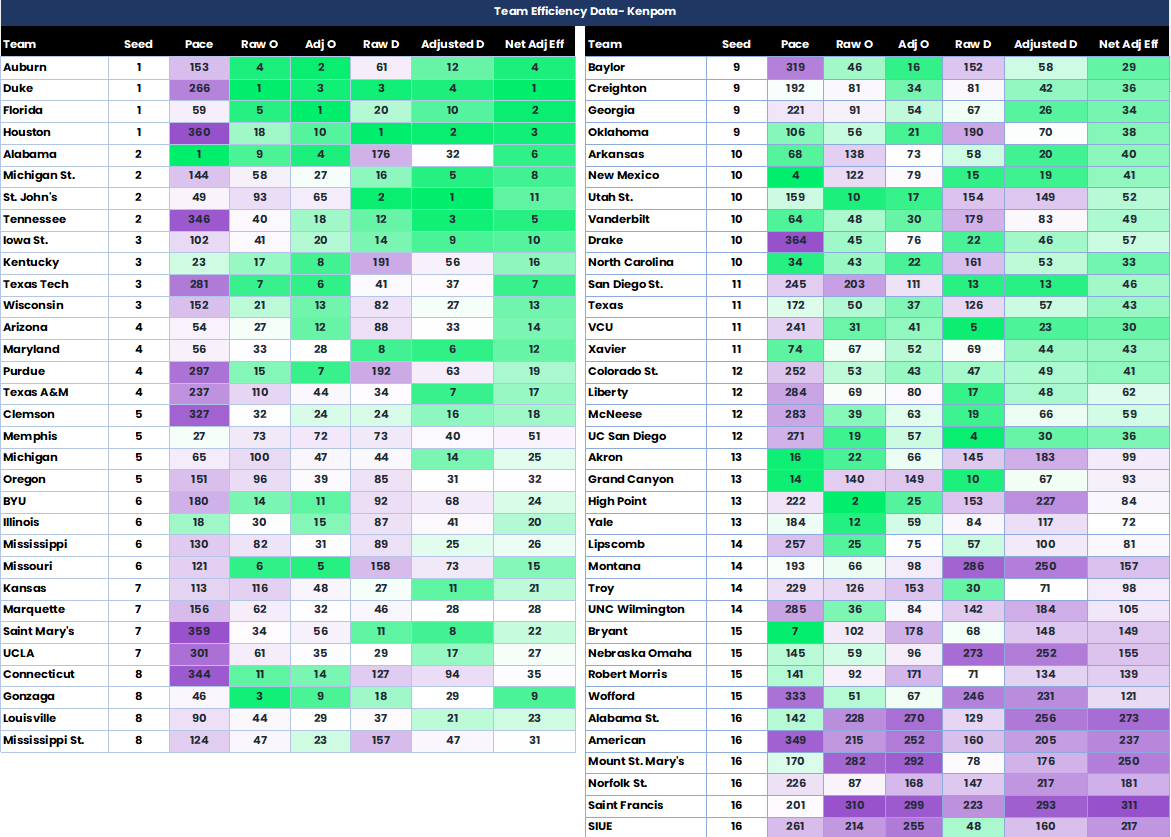
Lets take a historical look at the profile of an NCAA tournament champion. Below are the pre tournament Kenpom rankings across raw points per possession, adjusted offense, raw points allowed per possession, adjusted defensive efficiency and total efficiency margin since 2001.
When you include the runners-up as well, no team has made the NCAA tournament championship game with an adjusted offensive rating worse than 62nd, a defensive rating of worse than 69th or with a total net efficiency margin worse than 44th. The 2011 Butler Bulldogs were a big outlier, ranking 69th in adjusted defense and 44th in overall net rating. If you exclude that team, no runner up or title winner entered the tournament worse than 29th in overall net rating.
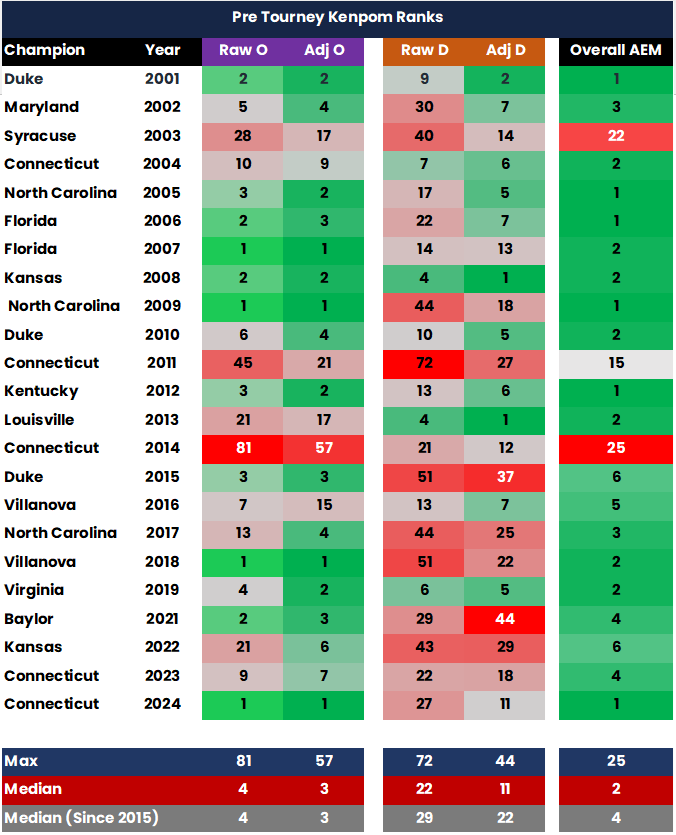

Who are the likeliest title contenders based on historical criteria? To keep it fairly simple, I am using a filter for the teams that rank in the Kenpom top 25 overall, are top 20 in adjusted offense (also top 50 in raw pts/poss), top 50 in adjusted defense and if not in the top 6 overall in Kenpom ratings has at least one win over a top five Kenpom team this season. In addition, I eliminated two teams that were not ranked in the AP preseason top 25 (MSU and St John’s).
My historical filters has led me to a list of 7 true title contenders. Duke, Florida, Houston, Auburn, Tennessee, Alabama and Texas Tech. These will be the only teams that I will be choosing from in my brackets to win it all.
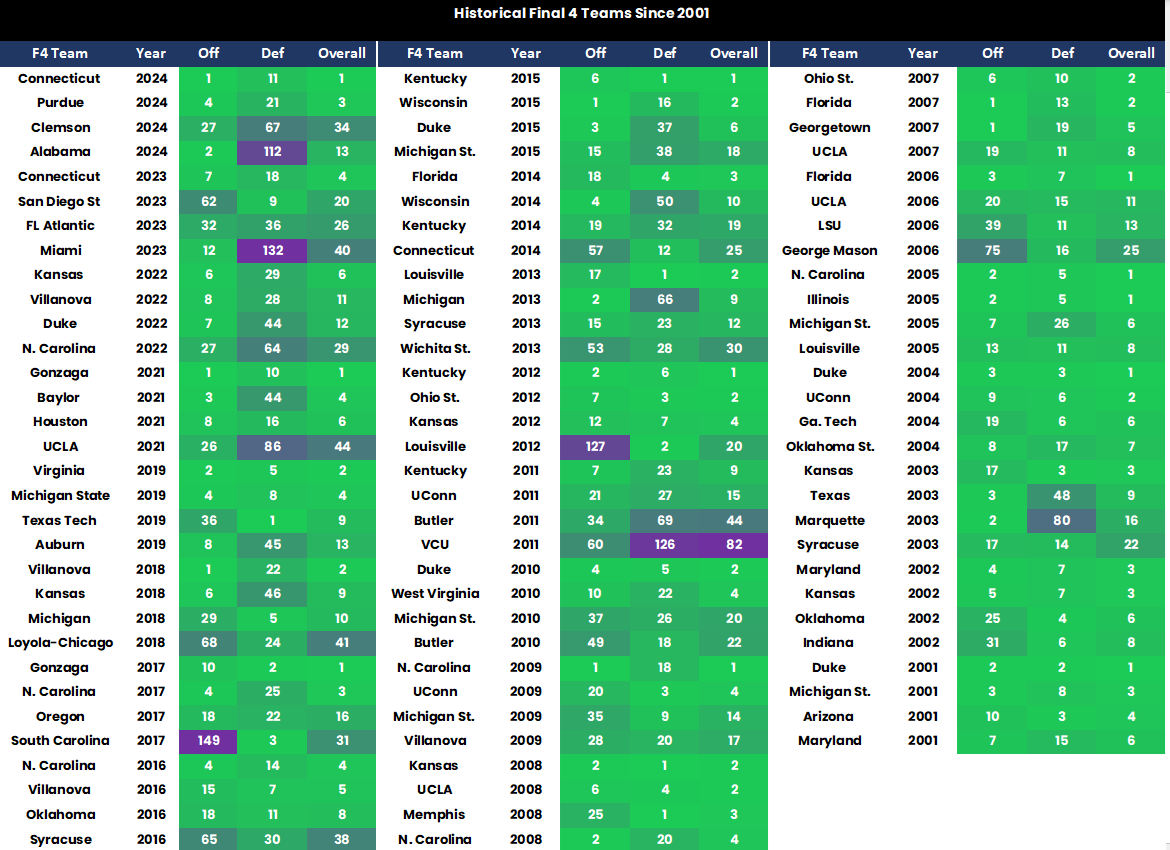
Who are the top seeds that could be primed for a big upset early? Historically, we have seen a pattern among higher seeded teams that are prolific on offense but mediocre to poor on defense, be ripe for an early upset. Nothing is hard and fast as a rule but more of blinking red warning lights. Teams that don’t play consistently good “enough” defense and get key stops find it very difficult to string together multiple tournament wins in a row for a deep run. However, because we are looking for higher seeded teams (7 seed or better) that may fit the upset bill, they must have likely also been really good on offense in order to receive such a high seed. Those are the types of teams we could fade from making a deep tournament run. Again, in smaller pools you may not need to pick many upsets but potentially fading 1-2 of these teams from making a deep run could give you some options.
Going back to 2001, there have been 45 teams that have been a top 7 seed ranked top 25 in raw offensive points per possession but with a raw defensive efficiency ranking of 135th or worse. Among these 45 teams, only two have made the Final 4 and ironically it has occurred in each of the last two seasons (Miami FL in 2023 and Alabama in 2024). Five others made the Elite 8 and 13 teams were upset by a double-digit seed in round one. That includes two last year with #3 seeded Kentucky losing to #14 Oakland and #7 Florida losing to #10 Colorado, both in round one. #3 Baylor survived the first round but got upset in round two by #6 Clemson.
Among the 45 teams that have qualified historically in my database, 71% have won their round one game vs an expectation of 75% based on their seed. These teams have won 0.17 games in the tournament less than expected based on their seed. In aggregate these teams have gone 19-25-1 ATS in round one games with a -2.0 ATS margin. If you isolate just those teams as big favorites (-10 or more), they have gone just 4-13-1 ATS in round one with a -4.8 ATS margin.
The overall straight up win percentage vs expected is not overwhelmingly poor but if you dig into #2 seeds, their results are a bit stunning. There have been seven #2 seeds that have fit this criteria since 2001 and five have won their 1st round games vs the 15 seed. Those two Ls may not sound like much but considering we have only seen seven #2 seeds since 2002 lose to a 15 seed out of 88 games and two of those seven have come with teams that fit this category, it is worth paying some attention. These #2 seeds had a pre game win expectation of 90% and they only won 5/7 (71%). They have also gone 0-6-1 ATS in those games with a -8.3 ATS margin. Further, out of the seven #2 seeds, two lost in round one and the five remaining teams that made it out of round one ALL HAVE LOST IN THE 2ND ROUND. Amazingly, all five of those #2 seeds lost by at least six points to their opponent including two losses by double digits. The teams that fit this criteria are below including the sole #2 seed this year- Alabama. The Crimson Tide are currently a 23.5 point favorite over Robert Morris.


Every year the biggest question is who can be this year’s Cinderella? They come in all shapes and sizes but I will do my best to try and profile what historically has proven to be the characteristics that can match some teams this season. For point of reference, there have been 17 teams seeded 11 or higher to make the Sweet 16 since 2014 and at least one has made it in every year. Since 2014, 11 of the 17 teams seeded 11 or higher to make the Sweet 16 have come from one of the big conference schools. Last season, NC State from the ACC was the only double digit seed to make the Sweet 16 as an 11 seed. Now let’s remember that this is a small sample of teams and there is lots of variance needed to win in an upset. Sometimes it’s as simple as a team getting hot from 3 or the opponent going ice cold, etc.
But a few things do stand out. For one, the median adjusted tempo that these teams played with ranked 232nd in the country. Seven of the 17 teams that have pulled multiple upsets, had a tempo that ranked over 300th in the country and only one (2021 Oral Roberts) was a fast paced team inisde the top 100 nationally. The two teams that played the fastest tempo in this group (2021 Oral Roberts and 2015 UCLA) also were excellent 3-point shooting teams. Oral ranked 20th and UCLA 71st in 3pt percentage so they could get away with a lot of possessions since they made a lot of 3s. But in general, a big chunk of these 11+ seeded teams that reached the Sweet 16 in recent memory, played at a generally slower pace. And that makes sense since in order to increase your odds of beating a better, more talented team, you want to maximize the variance by decreasing the number of possessions as much as possible. Three of the recent 11+ seeded upset teams that came from non Power 5- Loyola in 2018, Saint Peter’s in 2022 and Princeton last season, were extremely slow and all ranked top 90 in lowest raw points per possession allowed.
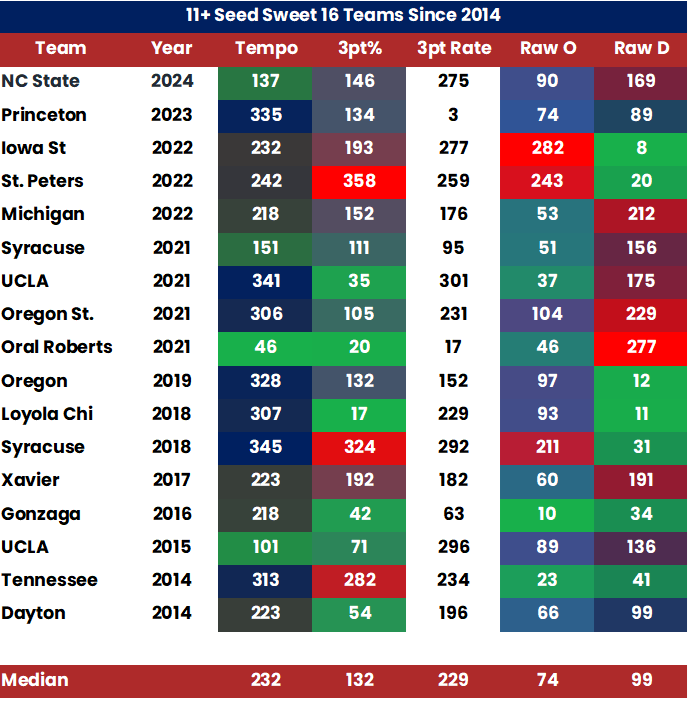
The other thing that really helps is taking advantage of what your opponent is weak at defending. If the higher seeded team lets you have extra chances to score (opponent offensive rebounding) or doesn’t take away chances for you to score (bad turnover rate on defense) then that will help the underdog. So finding a good combo of a double digit seed who keeps things slow, can make some threes but also plays an opponent who doesn’t minimize your chances to score, is ideal for an upset or two. Here are some candidates:
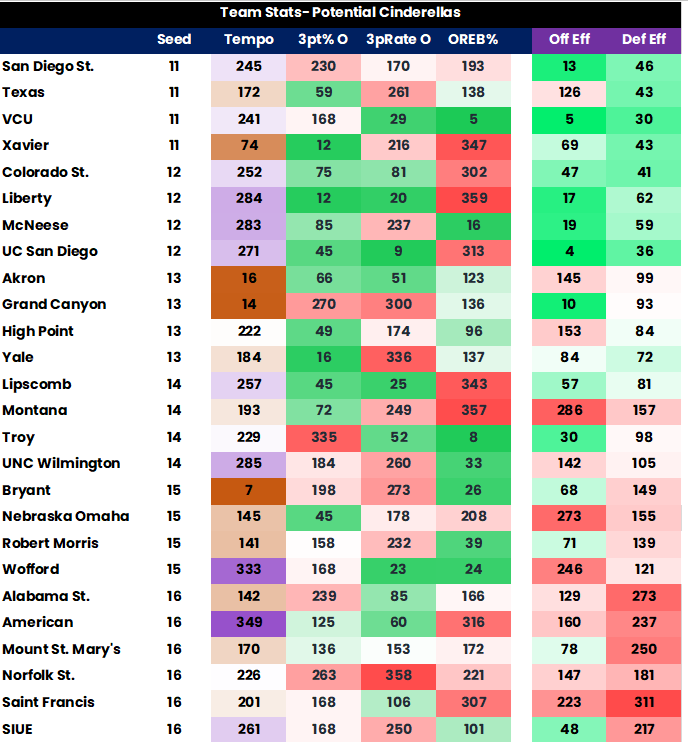
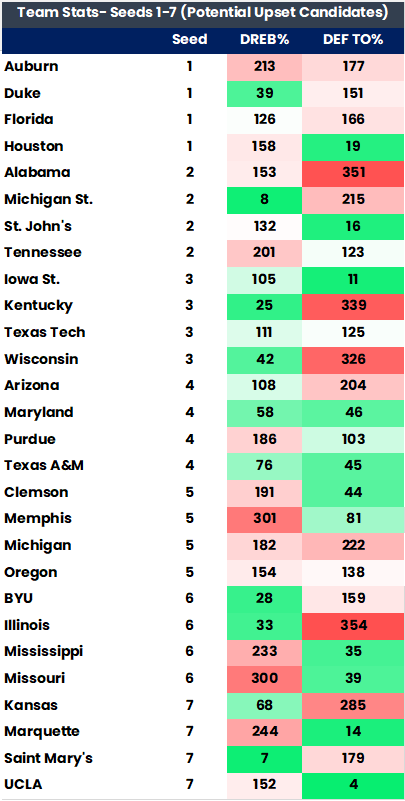
When evaluating those potential 11+ seed Cinderella teams, we would love to marry those that can slow down the pace, hit some 3s and face an opponent who doesn’t turn over teams at a high rate and will allow some offensive rebound opportunities. Top seeded teams like Illinois, Alabama, Wisconsin, Kentucky, Michigan and Kansas all pop as teams that allow a good amount of 2nd chances and possessions for opponents. These teams all rank 260th or worse nationally in opponent effective possession ratio which essentially measures the number of shot opportunities allowed per possession.
Comparing betting odds to win the title versus what the general public is picking can also help find good value. Using the table below to find teams that are undervalued from a championship standpoint in brackets is useful for large pools. (only teams with 1% or more win probability listed).
As you can see among the top seeds, Auburn and Houston are clearly showing the best “value” between true odds to win the Championship and public perception. Duke and Florida are the most overvalued teams but quite honestly as compared to prior years, 1% (Florida) and 2.1% (Duke) are not too egregious. By comparison, last year we had two teams (UCONN and UNC) overvalued by more than 4%. I would not necessarily fade either Florida or Duke based on this but in very large pools you should also strongly consider Auburn and Houston if entering multiple brackets.
